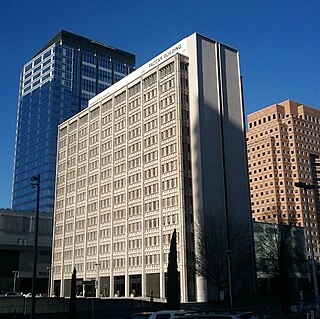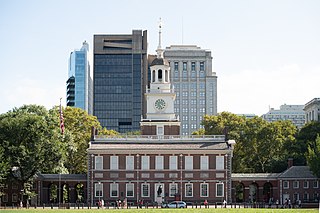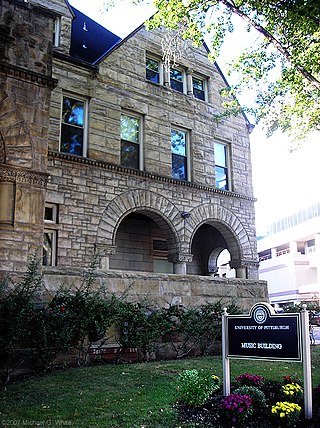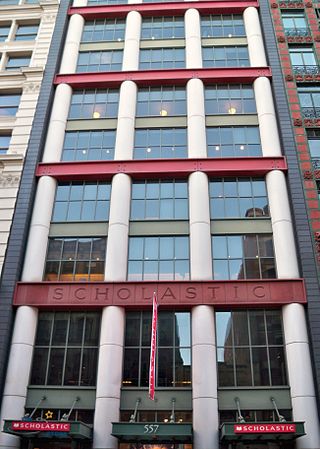
Cold Spring is a village in the town of Philipstown in Putnam County, New York, United States. The population was 1,986 at the 2020 census. It borders the smaller village of Nelsonville and the hamlets of Garrison and North Highlands. The central area of the village is on the National Register of Historic Places as the Cold Spring Historic District due to its many well-preserved 19th-century buildings, constructed to accommodate workers at the nearby West Point Foundry. The town is the birthplace of General Gouverneur K. Warren, who was an important figure in the Union Army during the Civil War. The village, located in the Hudson Highlands, sits at the deepest point of the Hudson River, directly across from West Point. Cold Spring serves as a weekend getaway for many residents of New York City.

The history of Pittsburgh began with centuries of Native American civilization in the modern Pittsburgh region, known as "Dionde:gâ'" in the Seneca language. Eventually, European explorers encountered the strategic confluence where the Allegheny and Monongahela Rivers meet to form the Ohio, which leads to the Mississippi River. The area became a battleground when France and Great Britain fought for control in the 1750s. When the British were victorious, the French ceded control of territories east of the Mississippi.

Paccar Inc is an American Fortune 500 company and counts among the largest manufacturers of medium- and heavy-duty trucks in the world, and has substantial manufacturing in light and medium vehicles through its various subsidiaries. It was originally founded as the Seattle Car Manufacturing Company in 1905, primarily producing railroad equipment. In the 21st century, Paccar primarily manufactures trucks and heavy equipment.

A National Historic Landmark (NHL) is a building, district, object, site, or structure that is officially recognized by the United States government for its outstanding historical significance. Only some 2,500 (~3%) of over 90,000 places listed on the country's National Register of Historic Places are recognized as National Historic Landmarks.

Canadian Car and Foundry (CC&F), also variously known as "Canadian Car & Foundry" or more familiarly as "Can Car", was a manufacturer of buses, railway rolling stock, forestry equipment, and later aircraft for the Canadian market. CC&F history goes back to 1897, but the main company was established in 1909 from an amalgamation of several companies and later became part of Hawker Siddeley Canada through the purchase by A.V. Roe Canada in 1957. Today the remaining factories are part of Alstom after its acquisition of Bombardier Transportation completed in 2021.

The South Side Flats is a neighborhood in Pittsburgh, Pennsylvania's South Side area. It is located just south of the Monongahela River. The neighborhood has one of the City of Pittsburgh's largest concentrations of 19th-century homes, which has prompted outsiders to call the neighborhood the City's Georgetown. It includes many bars and restaurants as well as residences. The main throughway in the South Side Flats is East Carson Street. The street is home to a significant portion of Pittsburgh's nightlife.

The Phoenix Iron Works, located in Phoenixville, Pennsylvania, was a manufacturer of iron and related products during the 19th century and early 20th century. Phoenix Iron Company was a major producer of cannons for the Union Army during the American Civil War. The company also produced the Phoenix column, an advance in construction material. Company facilities are a core component of the Phoenixville Historic District, a National Register of Historic Places site that was in 2006 recognized as a historic landmark by ASM International.

William Hartman McFadden was an American businessman and an essential factor in opening up the oil fields of Oklahoma.
Founded in 1908 by oil exploration pioneer E. W. Marland, The 101 Ranch Oil Company was located on the Miller Brothers 101 Ranch and headquartered in Ponca City, Oklahoma. The company's 1911 oil discovery in North Eastern Oklahoma opened up oil development in a great region from Eastern Oklahoma west to Mervine, Newkirk, Blackwell, Billings and Garber and led to the founding of the Marland Oil Company, later renamed the Continental Oil Company, now known as Conoco.

Fort Pitt Museum is an indoor/outdoor museum that is administered by the Senator John Heinz History Center in downtown Pittsburgh, Allegheny County, Pennsylvania in the United States. It is at the confluence of the Monongahela and Allegheny Rivers, where the Ohio River is formed. Fort Pitt Museum is surrounded by Point State Park, a Pennsylvania state park named for the geographically and historically significant point that is between the rivers. This piece of land was key to controlling the upper reaches of the Ohio River Valley and western Pennsylvania, before, during and after the French and Indian War as well as the American Revolution.

Gardner Steel Conference Center (GSCC) is an academic building of the University of Pittsburgh and a contributing property to the Schenley Farms National Historic District and a Pittsburgh History and Landmarks Foundation Historic Landmark.
The Allegheny and South Side Railway is an historic railroad that operated in Pennsylvania.

Pittsburgh, Pennsylvania was a thriving and important city during the American Civil War, and provided a significant source of personnel, war materiel, armament, ammunition, and supplies to the Union Army. Situated at the confluence of the Monongahela, Allegheny and Ohio rivers, Pittsburgh was an important transportation hub for both riverine and rail transport, as well as overland via its system of roads.

The American Foundry Society (AFS) is a professional, technical and trade association for foundries and the broader metal casting industry. The society promotes the interests of foundries to policymakers, provides training for foundry workers, and supports research and technological advancements in foundry science and manufacturing.

Longfellow, Alden & Harlow, of Boston, Massachusetts, and Pittsburgh, Pennsylvania, was the architectural firm of Alexander Wadsworth Longfellow Jr. (1854–1934), Frank Ellis Alden (1859–1908), and Alfred Branch Harlow (1857–1927). The firm, successors to H. H. Richardson, continued to provide structures in the Romanesque revival style established by Richardson that is often referred to as Richardsonian Romanesque.

The Dry Dock Complex consists of six interconnected buildings located at 1801–1803 Atwater Street in Detroit, Michigan, as well as the remains of a nearby dry dock at 1900 Atwater Street. The 1801-1803 Atwater complex is also known as the Globe Trading Company Building, and in 2015 was opened by the Michigan Department of Natural Resources as the Outdoor Adventure Center.

Sheerness Dockyard also known as the Sheerness Station was a Royal Navy Dockyard located on the Sheerness peninsula, at the mouth of the River Medway in Kent. It was opened in the 1660s and closed in 1960.

The Carnegie Free Library of Allegheny is situated in the Allegheny Center neighborhood of Pittsburgh, Pennsylvania. It was commissioned in 1886, the first Carnegie library to be commissioned in the United States. Donated to the public by entrepreneur Andrew Carnegie, it was built from 1886 to 1890 on a design by John L. Smithmeyer and Paul J. Pelz.

The Scholastic Building is the 10-story headquarters of the Scholastic Corporation, located on Broadway between Prince and Spring Streets in the SoHo neighborhood of Manhattan, New York City. Built in 2001, it was the first new building to be constructed in the SoHo-Cast Iron Historic District, replacing a one-story garage built in 1954. It is the only building in New York ever to be designed by Italian architect, Aldo Rossi. Originally conceived of in his New York office, it was completed and refined by a disciple of his, Morris Adjmi. It is respectful of the neighboring buildings and pays homage to the district's cast iron architectural identity. The cast iron architecture that defines this neighborhood straddles between the classical and industrial periods of New York's past. According to historian William Higgins, "the building’s columnar Broadway façade, in steel, terra-cotta, and stone, echoes the scale and the formal, Classical character of its commercial neighbors. The rear façade, on Mercer Street, extracts a gritty essence from its more utilitarian surroundings of plain cast iron and weathered masonry." The Scholastic Building was designed and assembled using a "kit of parts" methodology, which is similar to a time when the facades of SoHo's cast-iron buildings were built by ordering the building elements and ornaments in parts from a catalog, having them cast off-site in foundries, and assembled on site.

Birdsboro Steel was an American producer of steel, machines, and machine parts based in Birdsboro, Pennsylvania. The company also produced munitions, tanks, and artillery in the late 1940s through their subsidiary company, Armorcast. Though the company wasn't officially established until around 1867, the roots of the company go as far back as 1740




















